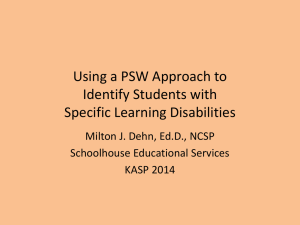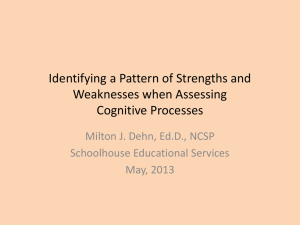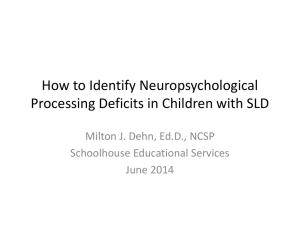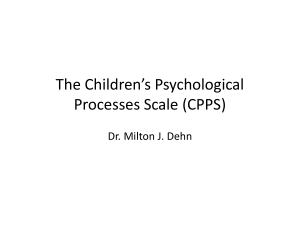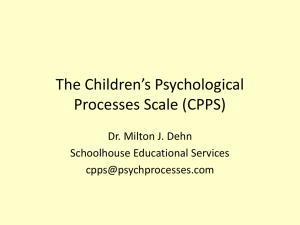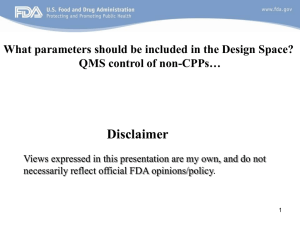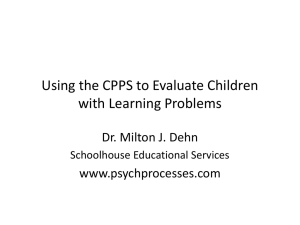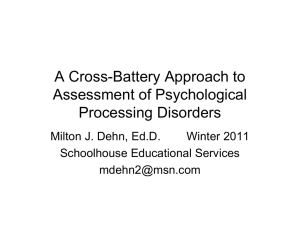Dehn, Milton 01
advertisement
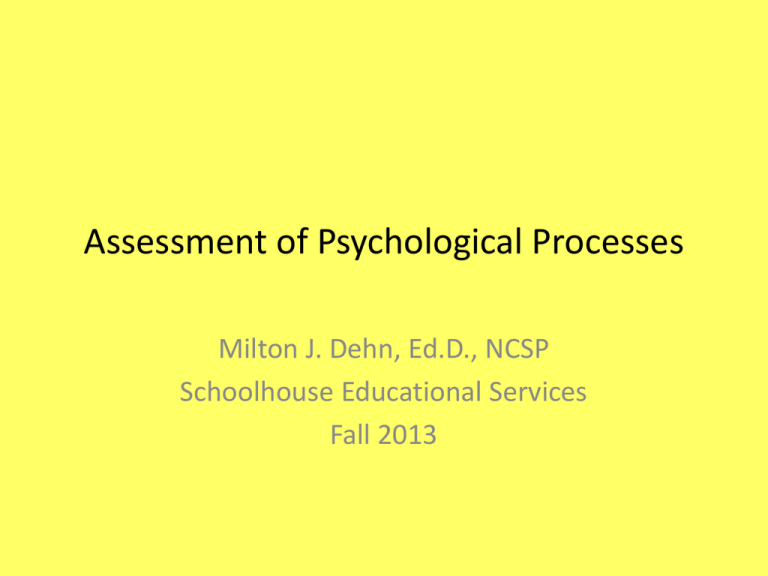
Assessment of Psychological Processes Milton J. Dehn, Ed.D., NCSP Schoolhouse Educational Services Fall 2013 Notice of Copyright 2013 This PowerPoint presentation and accompanying materials are copyrighted by Schoolhouse Educational Services, LLC. They are not to be reprinted, copied, or electronically disseminated without written permission. To obtain permission, email milt@psychprocesses.com. Workshop Information Sources • • • • • • Essentials of Processing Assessment, 2nd Ed. Children’s Psychological Processes Scale (CPPS) Psychological Processing Analyzer (PPA) Bibliography in handout www.psychprocesses.com Presenter Contact: milt@psychprocesses.com Workshop Topics 1. 2. 3. 4. 5. 6. Processes to assess Processes and academic skills PSW Models Selective, cross-battery testing Identifying processing deficits with the PPA Identifying processing deficits with the CPPS The Need for Processing Assessment 1. Part of a neuropsychological approach 2. Not just for SLD but Autism, ADHD, TBI, etc. 3. Neuroscience has increased understanding of brain-learning relationships 4. A deficit in a “psychological process” is part of federal and states’ SLD definitions 5. Identification of processing deficits leads to more appropriate & effective interventions What are Psychological Processes? 1. 2. 3. 4. 5. 6. 7. 8. Include “cognitive” processes Brain processes, operations, functions Any time mental contents are operated on When information is perceived, transformed, manipulated, stored, retrieved, expressed Whenever we think, reason, problem-solve Basic and higher level processes Doesn’t include knowledge or achievement Learning and performance depend on these processes; they underlie academic skills Human Processing Limitations 1. Human limitations 2. Which processes does the chimp excel at? Processes for SLD Assessment 1. Attention 2. Auditory Processing 3. Executive Functions 4. Fine Motor 5. Fluid Reasoning 6. Long-Term Recall 7. Oral Language 8. Phonological Processing 9. Processing Speed 10.Visual-Spatial Processing 11.Working Memory (WM) Processes and Academic Learning 1. Psychological processes are like “aptitudes” 2. Relations established through research 1. Flanagan et al., & McGrew 2. Swanson, Geary, and others 3. The influence of processes varies by age 4. For SLD look for academic area and related psychological processes to both be low 5. See Table Processing Clusters: Memory Example • • • • • • • Attention Executive Functions Fluid Reasoning Long-Term Recall Processing Speed Working Memory See Link for other clusters Developmental Groupings Mature early after gradual development: • Auditory Processing • Fine Motor Processing • Long-Term Recall • Phonological Processing • Visual-Spatial Processing • See link for other groupings PSW Principles Regarding SLD 1. 2. 3. 4. 5. 6. 7. 8. Neurologically-based deficits underlie SLD There’s no SLD if there’s no processing deficit Some processes highly related with academic skills Processing deficits related to academic deficits SLD have average or near average cognitive ability Weakness should be normative & intra-individual Weakness: statistically significant and unusual PSW doesn’t mean there is a learning disability. Concordance-Discordance Model 1. From James Brad Hale Link 2. Similar to Naglieri’s model 3. Processing areas not significantly related to the academic area should be discordant: Processing strengths should be significantly higher than the academic weakness CHC Model 1. A process related to the academic deficiency is weak or deficient 2. Unexpected underachievement: Process and academic deficit exist with otherwise normal ability 3. Regarding strengths, at least some processes should be in the average range Dehn’s PSW Model 1. 2. 3. 4. 5. 6. 7. Normative weakness + intra-individual weakness = deficit (3 reasons for deficit emphasis) At least one process is a deficit Intra-individual weakness is statistically significant Subtest scores must be unitary for a deficit At least one processes is in average range (a strength) The deficit is related to deficient academic skill Consistency between low process score(s) and the related low academic skill score Processing Assessment Challenges 1. 2. 3. 4. 5. Connecting to academic concerns Interrelated processes Not all are found in one convenient battery Doing it efficiently Linking with interventions Dehn’s Cross-Battery Processing Assessment Model 1. Not limited to CHC factors 2. “Narrow” abilities/processes included 3. Includes processing factors that are important for learning of academic skills 4. Includes rating scales 5. Subtests classified through task analysis 6. Analyze scores at the composite (twosubtest) level whenever possible Cross-Battery, Selective Testing 1. Test all processes important for academics With most attention to an in-depth assessment of hypothesized weaknesses 2. Pick composites first 3. Categorized by factor and task analysis 4. See selective testing table Link 5. See comprehensive list link from Essentials of Processing Assessment, 2nd Edition Task Analysis/Classification of Subtests 1. Consider definition of the process 2. Consider factor analytic information 3. What is the primary process being measured by the subtest? (not just input or output) 4. Which primary process allows the examinee to successfully complete the task 5. What the task is typically used to measure 6. No such thing as “pure” subtest measure Planning Processing Assessment 1. Assess most major processes, especially those hypothesized to be deficits 2. Identify academic deficiencies 3. Generate processing deficit hypotheses based on relations with academics 4. Decide on method; some informal okay 5. Select tests and subtests, not entire batteries Hypothesis Testing Approach 1. Given academic deficiency, what are the most likely process deficits 2. It’s “why” the child has a learning problem 3. Include non-processes 4. Must collect assessment data to “test” hypotheses 5. Try to avoid “confirmatory bias” 6. We all have weaknesses Planning a Processing Assessment 1. Complete the processing assessment planner 2. Completed example Processing Analysis 1. 2. 3. 4. 5. 6. 7. 8. Composite scores from test manual when possible Convert all scores to standard scores Compute clinical scores by averaging Compute processing or memory mean or use IQ Calculate discrepancies Determine weaknesses and deficits Both kinds of weaknesses = a deficit Do pairwise comparisons 1. Opposites and those closely related 9. Completed Example Guidelines for Weaknesses & Deficits 1. Scores below 90 are normative weaknesses 1. Below 85 if not using deficit approach 2. Intra-individual strengths & weaknesses use 12 points 1. Assumes composites/subtests have hi reliability 2. Use 15 points if not using deficit approach 3. Deficit = both normative and intra-individual weakness (deficit is a “strong” weakness) Pairwise Comparisons 1. For intervention planning, not diagnosis 2. Pay most attention to: 1. Opposites 2. Those that are closely related 3. A greater discrepancy is required for significance 4. Significant when confidence intervals do not overlap Using Dehn’s Automated Analysis Worksheet to Determine PSW 1. Automated worksheet from Essentials of Processing, 2nd Edition Psychological Processing Analyzer 2.0 1. Available at www.psychprocesses.com 2. Identifies statistically significant strengths, weaknesses, deficits, and assets 3. Can use composite or subtest scores 4. 11 psychological processes 5. Takes scores (almost 400 to choose from) from 41 different scales: cognitive, achievement, rating, and processing Psychological Processing Analyzer 1. Normally use the mean of the process scores as predicted score 1. Predicted score for each process based on mean of other 10 2. But IQ or cognitive composite is an option when not many processes assessed or only weak processes assessed 3. Differences greater than critical values are intra-individual weaknesses Psychological Processing Analyzer 1. Composite and subtests are limited to those that are fairly direct measures 2. Some are re-classified based on the primary demands of the task 3. Difference formulas based on reliability coefficients of composites/subtests 4. Regression toward the mean 5. .01 or .05 level of significance Psychological Processing Analyzer 1. It converts all scores (except raw scores) to standard scores 2. Non-unitary process scores are flagged 3. Deficits are both types of weaknesses 4. Pairwise comparisons also provided 5. Graph and brief narrative 6. See demo with Case Study Data Rating Scales 1. Processing deficits are manifested through behaviors 2. Behavior ratings can be used to measure processing abilities 3. Examples: BRIEF and other Executive Function Scales 4. Also, the new CPPS Children’s Psychological Processes Scale (CPPS) Overview 1. 2. 3. 4. 5. 6. 7. Standardized teacher rating scale Ages 5-0-0 to 12-11-30 121 items across 11 subscales Entirely online, internet-web based Online administration time of 15 minutes Online scoring and report Author: Milton Dehn; published by Schoolhouse Educational Services, 2012 8. Measurement Consultant: Kevin McGrew Uses of the CPPS 1. Learning Disability Evaluations 1. Identify psych processing deficits 2. Pattern of strengths and weaknesses 3. One method of evaluating processing 2. Screening 1. Identifies need for intervention 2. Predicts academic skills development 3. Planning cognitive/neuropsychological testing 3. Measure progress during interventions 1. Through the use of change-sensitive W-scores CPPS Standardization 1. 2. 3. 4. 5. 6. 7. 1,121 students rated by 278 teachers 128 communities in 30 states All data collected online Demographics match U.S. Census well Norms: 4 age groups (5-6; 7-8; 9-10; 11-12) Included children with disabilities Demographics details Link CPPS Processes 1. Attention 2. Auditory Processing 3. Executive Functions 4. Fine Motor 5. Fluid Reasoning 6. Long-Term Recall 7. Oral Language 8. Phonological Processing 9. Processing Speed 10.Visual-Spatial Processing 11.Working Memory (WM) CPPS General Processing Ability (GPA) 1. Based on average of all process scores 2. Emerges from factor analysis; similar to concept of general intelligence 3. Processes function in an inter-related fashion 4. Most processes contribute to any given behavior, task 5. On CPPS defined as “the underlying efficiency of processing” CPPS Items • Grouped by subscale Link • In developmental (ability) order from lowest item to highest item • Example of scoring in developmental sequence Link CPPS Administration 1. Online teacher rating scale 12-15 minutes 1. Can print free paper copy and enter later 2. Must answer all items (but can save incomplete) 2. Never, Sometimes, Often, Almost Always 3. Rating scale saved until report generated How The Online CPPS Works 1. A psychologist’s side and a teacher’s side 2. Psychologist fills in teacher information and email sent 3. Teacher completes ratings 4. Psych receives email stating ratings complete 5. Psych generates report 6. See screen shots CPPS Report 1. 2. 3. 4. Brief narrative, graph, and a table of scores Change-sensitive W-scores T-scores; percentiles; confidence intervals Intra-individual strengths and weakness discrepancy table 5. T-score to standard score converter 6. Example CPPS Discrepancy Analysis 1. Use discrepancy table to determine pattern of strengths and weaknesses 2. Predicted score based on mean of other 10 3. Regression toward the mean included 4. +/- 1.00 to 2.00 SD of SEE discrepancy options 5. Strengths and Weakness labeling is opposite of discrepancy, e.g. “-” value = a strength 6. Link T-Score Conversion Table 1. Optional 2. Purpose: To see how consistent CPPS scores are with achievement and cognitive scores 3. T-score x 1.5 + 25 and then reverse distance from mean 4. Example: T-score of 60 x 1.5 = 90 + 25 = 115 5. Then subtract 15 from 100 = 85 Example Diagnosing LD with the CPPS 1. Look for pattern of strengths and weaknesses (discrepancy table) 2. Weaknesses should also be normative weaknesses (T-scores above 60) 3. Weaknesses should link to evidence-based achievement relations 4. Same criteria as PSW model Diagnostic Accuracy for LD 1. 37 LD subjects with broad demographics 2. Compared to matched controls, LD subjects had significantly higher means on all subscales Link 3. The CPPS had high classification accuracy in regards to LD 1. Using CPPS GPA cutoff of 60 had a 92% classification accuracy across 74 subjects Frequently Asked CPPS Questions 1. 2. 3. 4. 5. Is there a paper form? Can I print individual item ratings? Security? Students 13 and older? Parent form? Reviewer #1 Comments “The technical documentation and delivery package of the CPPS is quite impressive for an assessment measure at its price point. Its coverage of the full spectrum of processing abilities through rating scale technology is a welcome addition to the cognitive assessment field.” Ryan J. McGill, Journal of Psychoeducational Assessment, 2013, 31:423 Reviewer #2 Comments “The CPPS provides an innovative, easily administered and scored, and potentially useful instrument……Evidence of convergent and discriminant validity is impressive for such a new scale.” Madle, R. A. (2013; in press) Review in Mental Measurements Yearbook, Volume 19.
